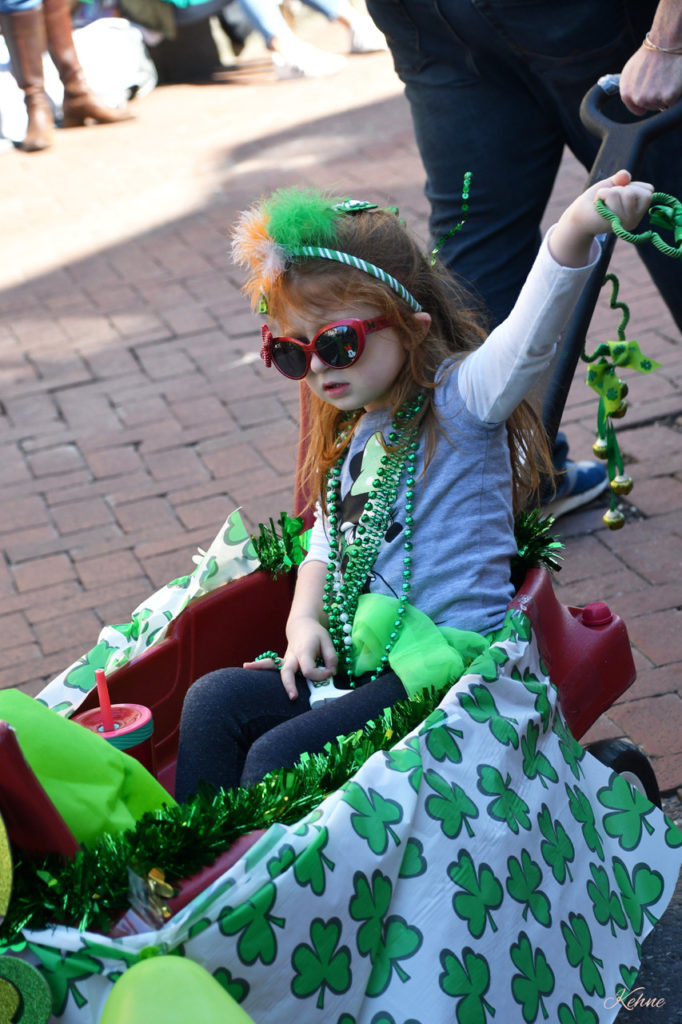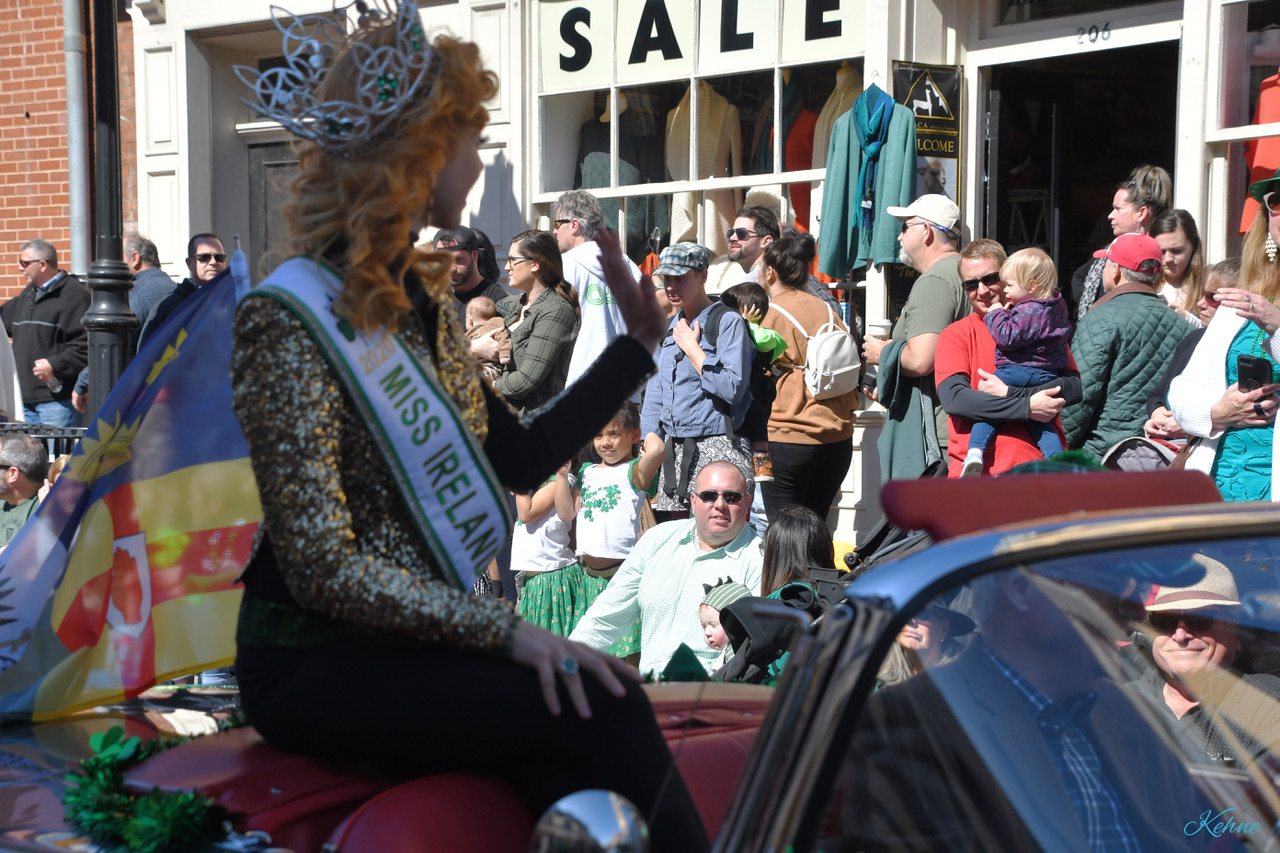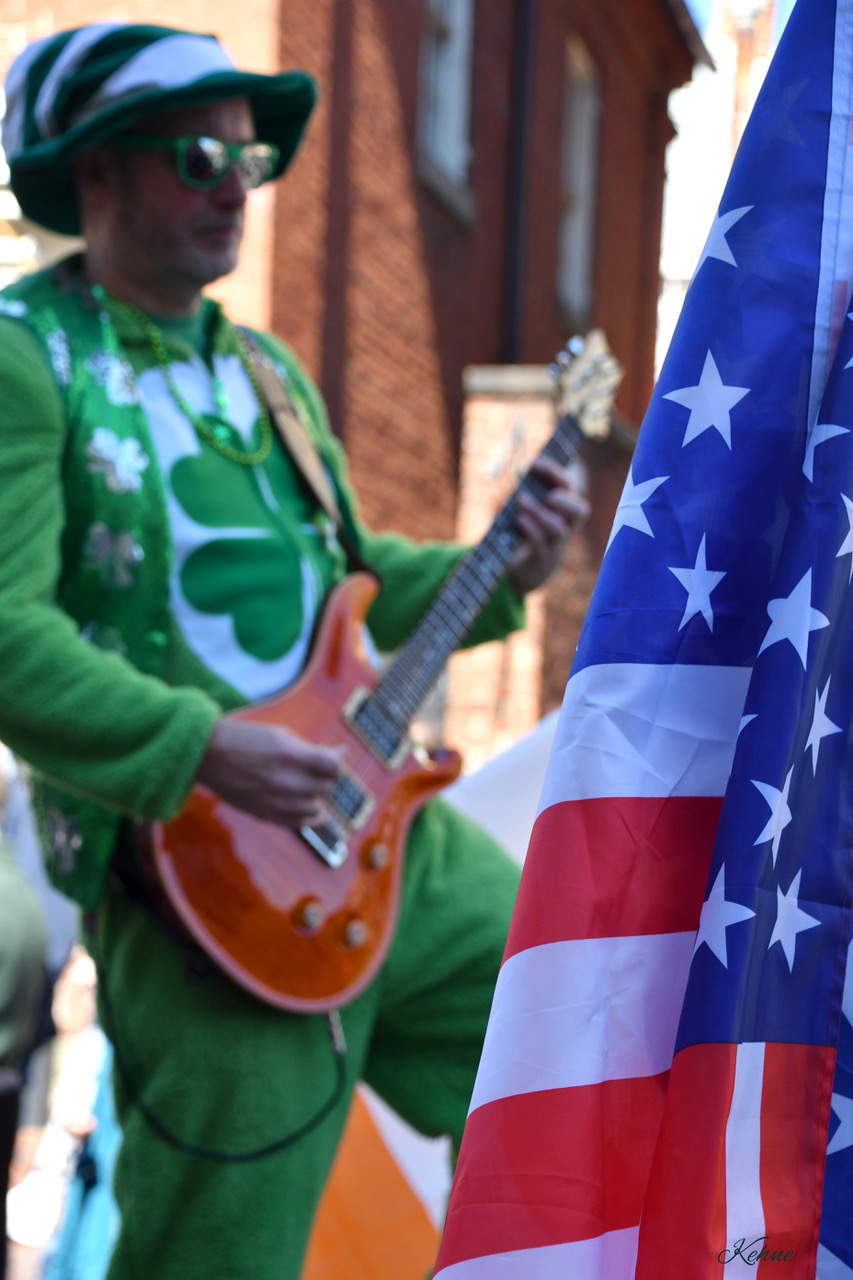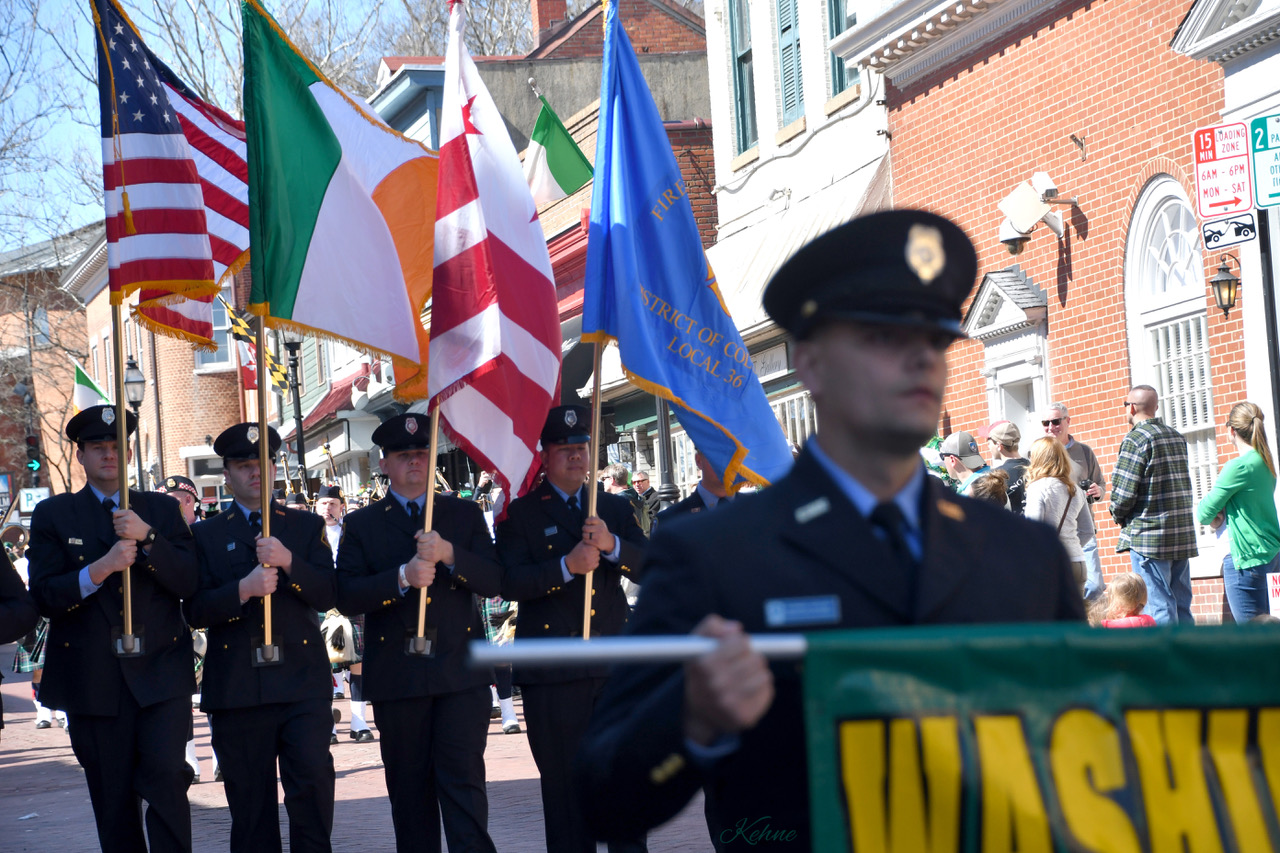Painting the Town Green

Annapolis celebrates return of St. Patrick’s Day festivities
By MacDuff Perkins
Annapolis ushers in the unofficial Celtic High Holy Season when the annual St. Patrick’s Day Parade returns after a two-year hiatus. The parade kicks off promptly at 1pm this Sunday (March 6), sending the colors green, orange, and white bleeding down Main Street down to the water at Dock Street. It’s a day for pipes on the breeze, step dancers on their toes, and Guinness in your hand.
Annapolis has a strong connection to Ireland, with shops like Irish Traditions on its Main Street and pubs like Galway Bay on the back streets. The weekend celebration showcases this connection and welcomes others to the unique traditions and heritage: Irish energy is captivating, and it’s meant to be shared.
If you plan on attending the parade, it’s best to get there early. “Whole families camp out so that they get a good spot to spectate,” says John O’Leary, the parade’s founder and director.
The parade itself is early—almost two weeks before the actual day commemorating Ireland’s patron saint. Originally, the earlier date was meant to allow Annapolis to celebrate the day without having to compete with other cities and their festivities. But in the ten years since, the early start just means a longer celebration of Irish culture and heritage (and yes, beverages) has developed.
O’Leary and his organization Naptown Events put on three events over the course of the weekend: The Hooley, an Irish-inspired parade kick-off party and fundraiser on Saturday night; the parade on Sunday; and Shamrock the Dock, a family-friendly post-parade party with live music, dancing, and plenty of activities to keep the wee ones entertained.
“The city wanted more than just a good party,” O’Leary says. To address this, Naptown Events worked to develop events that both offered a great party but also highlighted the Irish community in Annapolis. “I’m John O’Leary,” he says. “I like supporting the Irish as well as this great city we live in. And the parade weekend has put us on the map, in this sense.”
Galway Bay, the Irish pub on Maryland Avenue owned by Michael Galway of Kilkenny, Ireland, and Anthony Clarke of Dublin, has been an important part of the Irish community since it opened. “We opened Galway Bay in December of 1995, and we immediately started finding that there was a large Irish population in Annapolis,” says Clarke.
Galway and Clarke knew each other as Irish emigres working in Falls Church, Va., before they decided to open the pub. “The town itself has character,” Clarke says, of Annapolis. “It’s a close-knit community, with condensed streets whether you live in the city or the country. And its proximity to the water reminded us of Galway.”
Galway Bay and Castlebay Pub opened around the same time, and instantly changed the environment of downtown Annapolis. “We introduced Irish culture to the bar scene,” Clarke says. “You could come into the bar, have a nice conversation, and there was always the chance that somebody might start singing.”
Parade weekend has a tendency to fly by (and certain moments remain rather hazy, for various reasons). But for Annapolitans, the celebration of Irish culture isn’t just for one weekend. Irish culture is alive and well, every day of the week.






Keeping Irish Traditions Alive
“Once Daylight Saving Time comes into effect, we’re rowing on Tuesdays, Thursdays, and Saturdays,” says Egan Nerich, founder of the Annapolis Irish Rowing Club. The club rows traditional Irish curraghs, watercraft from the southwest coast of Ireland. Legend has it that St. Brendan traveled from Ireland to North America in a fifth-century curragh on his seven-year quest for Paradise. Today, the wooden-framed boats are covered with stretched canvas and rowed by teams of two to eight. “They’re fast and meant for the ocean,” says Nerich, noting that they were used as a means of transportation between the mainland and smaller coastal islands, but also used for fishing and unloading the larger ships that couldn’t make it into the shallower harbors.
Today’s curraghs differ from modern rowing shells in that the oars are non-feathering, and the seats are fixed. Curraghs are heavy (roughly 250 pounds), requiring several adults to lift them. But once in the water, they’re quick and sturdy, maneuvering easily no matter the conditions.
Nerich mentions that the club is always looking for new recruits. “Annapolis is an Irish town, but it’s also a sailing town,” he says. “It’s hard to keep rowers.”
If it’s a challenge to keep traditional Irish rowers, you can imagine how hard it is to find a good bagpiper when you need one.
“There’s a physical element to playing it,” says Will Dirks, who works during the summers in yard and fleet management at the Annapolis Sailing School. As a child in Severna Park, Dirks studied the bagpipes with Sandy Jones, who was pipe major of the Air Force Pipe Band. He moved away from the area but returned in 2009, when he started working at the sailing school. He tried husking down on Church Circle, but found his pipes were no match for the electric amp that occupied a nearby street corner. Dirks began bringing his pipes to the school with him, practicing on the beach after work as the sun set on his back. “The bagpipes like wide open spaces, not the confinement of four walls.” Perfect for playing into the sea.
The bagpipes are historically a Scottish instrument, but the first record of pipes in Ireland dates back before the time of Christ. Dirks and his group Na Fianna, who perform out of Baltimore, choose to play from an all-Irish catalogue. “We play a mix of the traditional tunes and those associated with Irish independence, or rebel marches,” Dirks says.
Music to Move To
This year’s parade has six pipe bands joining, and they’ll mostly be playing traditional music made to get you on your feet. The beauty of Irish music is that the old standards are anything but: Irish music is a mood, or a mentality, reflective of its atmosphere. This atmosphere can change in an instant.
Ray Murphy, lead singer of the Irish band Dublin 5, says it best. “One of the unique things about Irish music is that it’s perfectly acceptable to take an Irish song (such as Whiskey in the Jar) and change the arrangement to make it your own. You may hear three or four different bands play the same song, and they’ll all be different.”
When Dublin 5 began performing, Murphy wasn’t so keen on performing the Irish ballads he felt he had left behind when he crossed the Atlantic Ocean. “One of our bandmates used to drag me back toward Irish music,” he says. Of the five musicians (Murphy on lead vocals; Jenn Belle on fiddle; Gary Hewitt on bass; and Jim Martin and Kevin Shoock on percussion), Murphy is the only one who hails from the Emerald Isle. “So, what we do is take an old Irish song and put rock and roll to it,” he says. “To me, live music is a celebration of the song. It’s not about the musician.”
Dublin 5’s music is a frenetic mixture of ballad, bass line, and boot-stomping. There’s a very squiggly line drawn between the sea shanty Murphy starts with and the energetic rock and roll he and the band perform before a pulsating crowd, but the band’s success is a testament to something greater. Perhaps it’s the music, and perhaps it’s the luck of the Irish.
Murphy hails from Dublin City, but has called Annapolis home for the last 20 years. As a musician, and as an Irishman, Murphy feels at home here for many reasons. “This is one of the few towns where any night of the week you can go out and see four tremendous bands—for free. After 20 years, I’m still not bored of it.”
Dublin 5 will be performing Saturday night during the Hooley, and again on Sunday at 5pm for Shamrock the Dock.
For musician Danny Burns, whose hometown is Ballyshannon in County Donegal, Irish music was an entrance to the American music scene. “I came here to play as a side guy with another guy from my hometown. Our first gigs were at Sean Donlons, the current Stan and Joe’s, and a few out in Ocean City.”
Burns started playing up and down the Eastern seaboard between New York and New Orleans, eventually landing in Nashville where he stepped out of the role as “side guy” and started headlining his own acts.
Burns’ music struck a chord in Nashville, where he created strong ties to Americana folk and bluegrass. But the shadowy instrumentals and haunting lyrics expose his deep Irish roots, showcasing the relationship between Irish ballads and American country music.
Performing has taken him around the country, but Burns often found himself shoehorned into a stereotype when he was labeled an Irish musician. “Sometimes events and festivals can be cheesy, and not representative of the community,” he says. After a few years in Nashville, Burns returned to Annapolis with his wife and children. Here he found a big town that was interested in local musicians, not just the high-dollar acts. He has family in the area (a cousin regularly performs at Brian Boru) and hometown friends between Washington, D.C., and Ocean City.
Burns last played Rams Head in December 2019, before the coronavirus put a temporary halt to live music. He returns to the stage with wife Aine O’Doherty as his opening act March 8.
“We’ll do the full band situation, and we’re going to bring a bit of Irish music, bluegrass, and rock it out,” he promises. “Everyone is invited.”
“The arts,” says Breda Pixley, “especially music and literature, is such a big part of Ireland. That’s very present in Annapolis, as well.” Pixley was born and raised in Lismore, County Waterford, and moved to Annapolis with her husband in 2005. Pixley’s husband occupied a post with the State Department, which had the couple moving around the world before settling down here. Immediately, she felt at home.
“There’s a strong sense of community here,” she says. “In a sense, it reminds me of Westport in County Mayo. We’re on the water, and the town itself has such a lovely atmosphere. That reminds me of being back home.”
With the exceptional pub culture, great live music, and a warm, welcoming social committee just waiting for you to show up, Annapolis is celebrating and showcasing Irish heritage on the daily. The St. Patrick’s Day Parade is simply an opportunity to bring more people to the party. Just remember to get there early. And if you want a seat at the bar, maybe go a day or two beforehand. “It’s ‘my’ day,” says O’Leary. “And even I can’t get into the pubs.”
This doesn’t dissuade anyone, however.
“I typically lead off the parade,” he continues, “and it’s such a pretty picture, seeing all the people, kids so excited, and green everywhere. It’s an incredibly happy day.”
If You Go:
- The parade steps off at 1pm from Amos Garrett Blvd. and leads down West Street to Main Street.
- Parking is available at the Naval Academy Stadium for $10 per car. The stadium lot opens at 10am.
- Free transportation is available between 10am and 6pm.
- Shamrock the Dock will follow the parade, beginning at 3pm with Irish dancers, pipe bands, children’s activities, and live music. A cash bar will be available. Naptownevents.com
